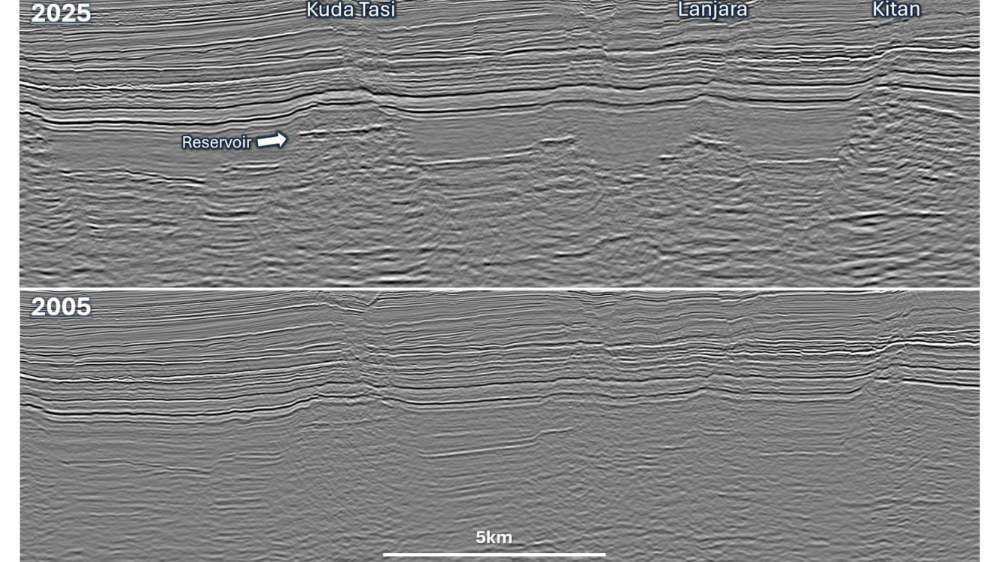Finder Energy’s newly reprocessed 3D seismic is the map for achieving first oil

Finder Energy will use the reprocessed data to map out its two oilfields, enabling optimised placement of development wells. Pic: Getty Images
- Finder Energy completes key reprocessing of 3D seismic data over its Kuda Tasi and Jahal oilfields
- Significant improvements in imaging have been observed and interpretation of data is now underway
- Higher quality data will be used to finalise placement of development wells to optimise production
Special Report: Finder Energy is now focused on finalising the placement of development wells at its Kuda Tasi and Jahal oilfields offshore Timor Leste after completing the Ikan 3D seismic reprocessing project in record time.
The reprocessing of 3D seismic data that was originally acquired over PSC 19-11 in 2005 was undertaken by EIF Geosolutions using modern, high-end DUG McCloud technology and focused on the Kuda Tasi and Jahal development area, which collectively host best estimate (2C) contingent resources of 22 million barrels (MMbbl) of oil.
It delivered excellent quality with significant improvements in imaging observed within the reservoir pay interval.
Finder Energy (ASX:FDR) has now started interpreting the reprocessed data with an immediate focus on updated mapping of the two oilfields to finalise placement of development wells to optimise production.
Additionally, the new data will be used to facilitate other project milestones critical to achieving first oil such as:
- Independent resource certification
- Production and economic modelling
- Preparation of the field development plan for Kuda Tasi and Jahal
- Re-evaluation of the resource potential of the Krill and Squilla discovered oilfields
- De-risking multiple high value exploration targets for drilling
- Securing industry partners and project funding

Excellent results
Technical director Shane Westlake said the company was able to reprocess the seismic data so quickly due to having teams in different time zones work rolling shifts for many months.
“The results are excellent and the data adds significant value to the project in many ways as well as supporting various ongoing activities in the PSC. Chief amongst these are our plans to accelerate first oil from Kuda Tasi and Jahal,” he added.
“Interpretation of the new data has already commenced and will proceed with the same sense of urgency and purpose.”
FDR notes the reprocessed data has far superior signal to noise ratio, especially within the primary targets of the Laminaria and Plover Formations.
It has also resolved imaging challenges beneath the complex shallow faulting, ensuring that the faults are well imaged and accurately positioned.
This will allow – for the first time in the PSC’s life-cycle – geologists to have high confidence mapping fault planes from the overburden, through the seal and into the reservoir.
Learnings from this will feed into the de-risking of the remaining prospects on the permit where trap breach and ultimately hydrocarbon retention remains the critical risk of the exploration play.
Listen: Rock Yarns Podcast Finder’s rising rewards of Asiatic oil
Kuda Tasi and Jahal development
FDR has a 76% stake in PSC 19-11, which hosts the Kuda Tasi and Jahal oilfields that are hosted in a proven oil system.
The historical Kuda Tasi-2 appraisal well has already demonstrated the potential for each development well to produce more than 20,000 barrels of oil per day – in line with wells producing from the same reservoir in adjacent fields such as Laminaria/Corallina, Buffalo and Kitan.
This has fed into modelling, which found that the two fields could produce up to 10MMbl of oil in the first 18 months of production.
A Subsea Concept Study has also been completed by experienced services provider Nobleseas Engineering to provide greater definition for development concepts and costings.
This covered schematic sketches for eight shortlisted concepts that illustrate the main subsea items relevant for cost estimates.
These include phased developments to potentially fast track first oil production.
Kuda Tasi and Jahal are expected to be developed through wells linked to a central manifold that in turn feeds into a floating production, storage and offtake vessel.
The company is currently evaluating the market for second-hand and refurbished equipment certified in accordance with regulations and good oilfield practice which could yield substantial capex savings and accelerate the project timeline to first oil.
This article was developed in collaboration with Finder Energy, a Stockhead advertiser at the time of publishing.
This article does not constitute financial product advice. You should consider obtaining independent advice before making any financial decisions.

UNLOCK INSIGHTS
Discover the untold stories of emerging ASX stocks.
Daily news and expert analysis, it's free to subscribe.
By proceeding, you confirm you understand that we handle personal information in accordance with our Privacy Policy.








